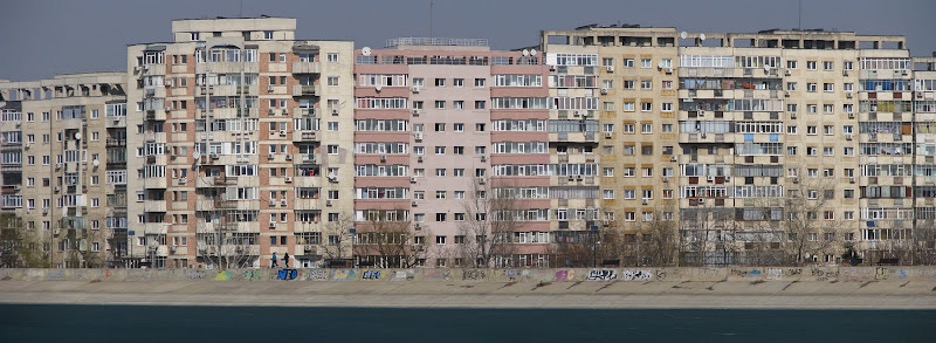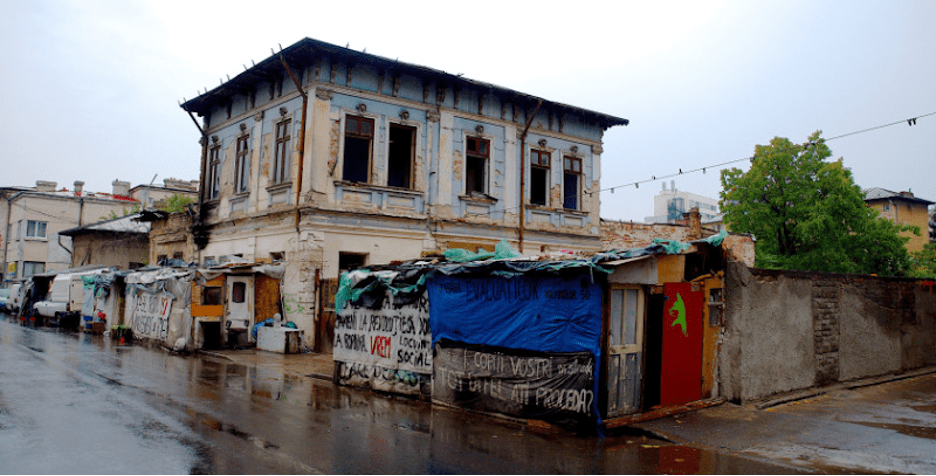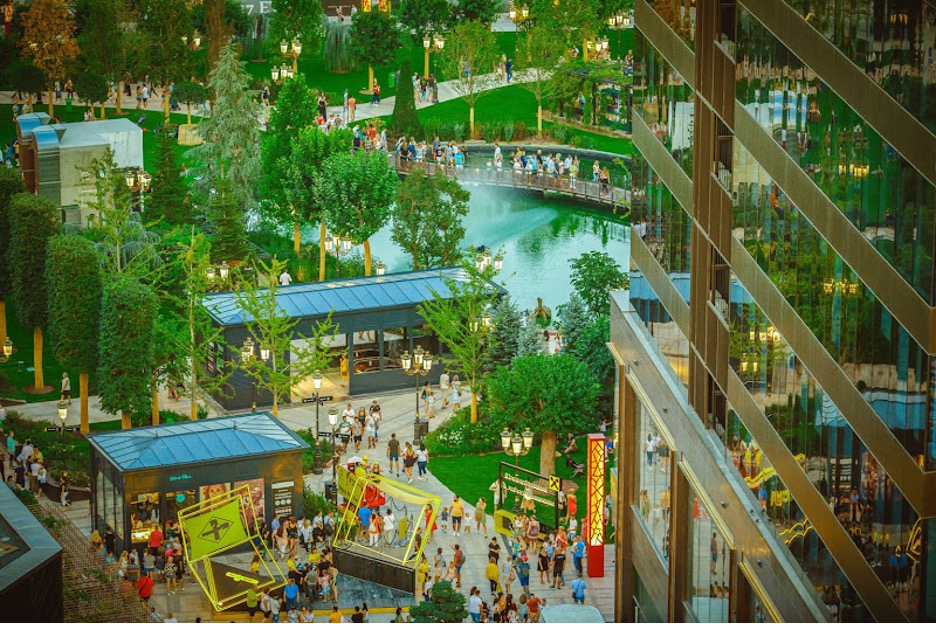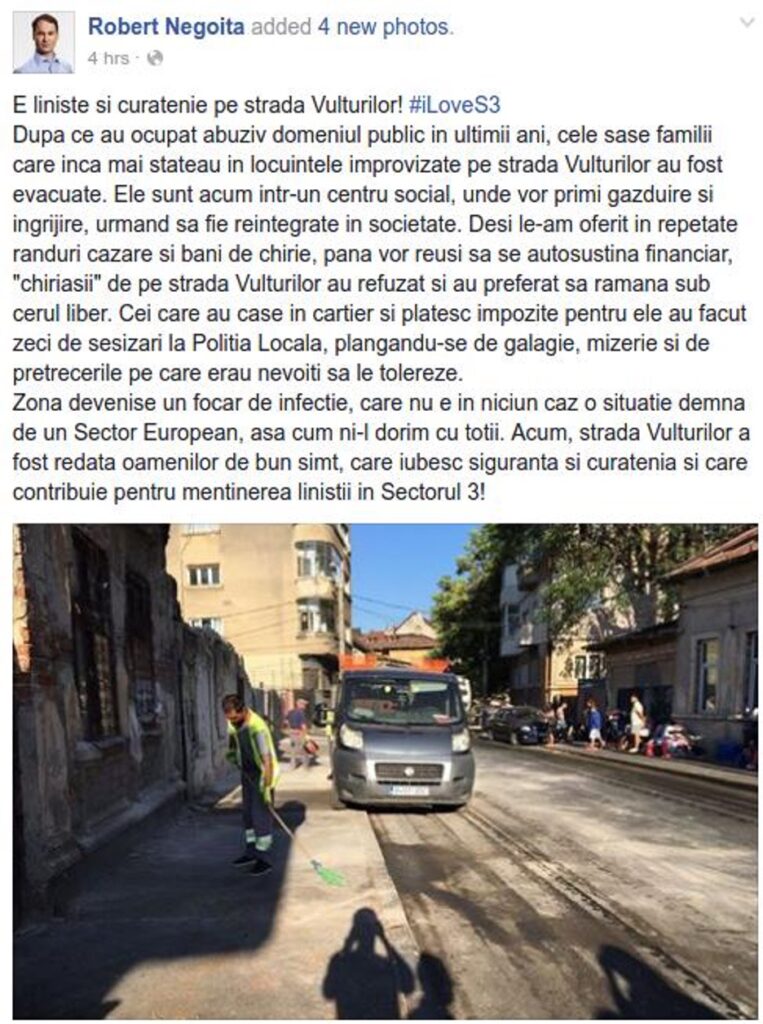This article is part of the multilingual ELMO series CEE housing movements resisting neoliberal urban transformations.
The smart city, the civilised city, the city for the respectable tax-paying citizens – in Central and Eastern Europe (CEE), what all of these urban imaginaries have in common is that they cater to a performative, aspirational desire of becoming Western. For the past thirty years, while our cities have seen the emergence of a great variety of urban social movements, municipalities and central governments have implemented a wide array of policies leading to neoliberal urban processes riding on the back of Westernisation.
This piece aims to reveal the workings of an aspirational Westernising paradigm in CEE post-socialist urban transformations by mapping out the story of Western superiority through which violent and high impact changes are legitimised. I take an engaged theorist approach based on my experience as an activist in the local (Romanian) and international housing justice movements. While pointing out local examples that I find of regional relevance, I seek to assemble a critical perspective aligned with urban movements dedicated to social justice from an anti-capitalist, anti-imperialist and intersectional perspective.
The illusion of options
Decolonial thought teaches us that for material domination to function, empire needs a variety of practices, vocabularies and values to enforce exploitation and extraction. It needs a consensus about who exploits, who is exploited, how and why. This builds up as a narrative upon which most, if not all, have to agree. Consenting to the story of exploitation, extraction and dispossession is not a simple task and it takes great societal resources for the ruling upper classes to produce said consent[1].
Furthermore, decolonial thought shows us that coloniality is not simply the consequence of colonial and imperial formations dominating over non-Western worlds, but goes beyond actual colonial administration and includes territories, societies that may have been in partial historical imperial domination[2]. Such is the case of CEE. Here, coloniality has a specific profile based on centuries of Western domination exercised partly by actual colonial rule, partly by complex financial and cultural dependencies. This history has produced Central and Eastern Europe as a semi-periphery, a financial, political and cultural process that has been long in the making and dates back centuries[3].
For this region, the narratives produced by the upper classes to legitimate violence and exploitation have always been linked to their aspiration of being recognised as representatives of either a Western or as good as a Western country. This is sought after either through nationalist, conservative approaches that aspire for the respect and recognition as an equal or through Westernisation resulting in integration. Simply put, CEE societies have been for centuries caught between these binary versions of development: nationalism vs. Westernisation[4]. The most worrying consequence of this binary is that it masks that both “options” actually consist of right-wing values and policies. Thus, both serve, one way or another, the integration of local societies into global flows of capital and the reproduction of the colonial hierarchy that puts the Western world over the rest.
One of the main components of the neoliberal victory after the historical end of the Cold War has been the consensus of anti-communism. Standing against past socialist and communist regimes has been signified as a “return to Europe”, a correction towards the so-called natural way of being part of the Western world. Together with the former socialist and communist regimes, a wide variety of leftist values and principles are deemed deviant, regardless if they actually overlap or not.
Thus, one of the most prevalent characteristics of the CEE post-socialist society is the marginalisation of political narratives – historical and contemporary – based on collective liberation both from authoritarianism and exploitation in all its forms. While such narratives are cornered in the shadows, what remains is the tired old binary of being either all for the nation or all for Westernisation. Any left-wing oriented narrative addressing labour exploitation, patriarchal dominance or state and military authoritarianism is usually swiftly redefined in the public sphere as being either retrograde, as in “communist”, or a Westernising foreign influence and thus, unnatural. So, for example, while unionization and labour struggles are frequently associated with the communist past and deemed backward, anti-racist or feminist struggles are considered too foreign and unfitting to the local context.
There is no acceptable “option” between two different versions of the same narrative that reinforces the superiority and dominance of the Western world. The key aspect I’d like to follow is that this story is the main story through which consent is socially produced. This means that any violence no matter how exploitative, or harmful can be explained and agreed upon as long as it fits the CEE version of the story of Western superiority. Consequently, a whole set of historically constructed ideas are naturalised: that CEE societies are lazy and corrupt, that local political elites are always worse than their Western counterparts, nothing gets done here, etc. One might say that these are simply stereotypes. But they actually are the tip of the iceberg on which other, more seriously oppressive narratives tag along. Such are: anti-Roma racism as an aspiration to whiteness paired with the denial of the history of Roma slavery in Romania[5], narratives legitimising the dehumanisation and dispossession of the working class or the comeback of fascist ideologies as a way of proving European greatness.
Erasing the past to pass as Western
The hegemonic story producing continuous consent to the variety of violence – the narrative of Western superiority – pervades through the domain of the urban in a version of unquestioned neoliberal aspiration. This means that when it comes to CEE cities, the unquestioned consensus is that they must become as Western looking and acting as possible[6]. While the apostles of the neoliberal city positioned as post-Cold War victors always find what they are looking for in CEE – chaotic cities marked by inconsistency, contradictions, inefficiency – becoming Western is considered somewhat of a universal cure for all these flaws.
In the journey of becoming Western, an indispensable phase of erasure of difference takes place. What has distinguished socialist and communist CEE urbanites from Western ones – industrial cities, vast working class neighbourhoods, the redistribution of building property and the urban planning dignifying community life – has been systematically dismantled. Difference as manifested in the remnants of communist and socialist past is depoliticized and progressively erased.[7]
Apart from the erasure of difference, coloniality works in various material and non-material ways to ciment the story of Western superiority. Ensuing material processes of exploitation, extraction and uneven development are of particular interest for the understanding of post-socialist urban transformations[8]. Complementary to such perspectives, in what follows, I’d like to focus on a specific way of how coloniality works in relation to the city: the discourse of aspirational Westernisation of urban spaces produces ongoing consent in regards to policies that consist of violent dislocations and dispossessions. As long as it remains unaddressed and unnamed as a construct, this narrative becomes naturalised. Unchallenged, this fiction presents itself as truth, producing the inevitability of Westernisation: before you know it, the becoming Western of your city is considered an obvious, natural development. Thus, the colonial construct of inevitable Westernisation alongside classist and racist narratives, forms a triade that serves as the foundation for consensus in the face of overt, systematic and systemic violence. While classist and racist readings are somewhat easier to identify and, to a degree, class and racial oriented critical positions are already present in the analysis of activists, a decolonial perspective is still to be developed.
For organisers and activists fighting capitalist neoliberalisation of our societies, I find it crucial to ground our work in the geo-political historical processes typical to our region. What sets our CEE social movements apart from our Western counterparts is that in our societies – and in other non-Western societies for that matter – violent dislocations and dispossessions are legitimised through the Westernising paradigm. To put it concretely, in the name of becoming Western we must all accept evictions, gentrification, touristification, financialisation, rising rents, mass dispossessions, etc.
I argue that becoming critical towards the story of Westernisation and the consent it produces is crucial for understanding and intervening in concrete contexts of violence. Breaking down this consent empowers us to see how, for example, the working class is criminalized and, at the same time, bring us closer to radical intersectional alliances through decolonial, anti-classist and anti-racist positionings.
Processes of urban transformations for passing as Western
1. Privatisation of housing
One of the most important dimensions of post-socialist transformations in CEE cities is the dismantling of the public housing paradigm. This has been done through two main steps: the actual privatisation of the public housing stock and then the delegitimation of the right to housing. Housing privatisation was largely done in the 1990s and led to post-socialist societies having a high number of home-owners. Workers that had never owned anything were suddenly owners of their own home, leading to a sense of class mobility. Doubled by an anti-communist vilification of working class culture, most of these people started seeing themselves as middle-class. This facilitated consent to the wider diversity of privatisations (of industry and land), presented as the only possible way to move into the capitalist future. Becoming Western by becoming capitalist masked the great loss of the fundamental right to housing. While so many started to think of themselves as middle-class, asking for housing from the state started to be understood as undignified. Public housing, which used to be considered a right of the workers, has become now a charity act for the most unfortunate.

As with many other post-socialist transformations, housing became understood as possible only as one of two ways: either in the state’s property as it was in socialist Romania, or in private hands, as the capitalist future demands. This dichotomy of nationalised vs. privatised effectively erased other histories that testify to the possibilities of third ways such as collectively owned housing as part of the complex history of resource commoning in the former socialist states in the region[9]. With the added layer of anti-communism, the dichotomy of national vs. private naturalised the idea of housing as a commodity, enabling a smoother neo-liberalisation. Housing as a right is still protected by law but it is considered secondary to private property. Divorced from any emancipatory vision based on social justice, redistribution or autonomy, policies around housing are now tailored to complement the legal framework that guarantees access and safeguards private property.[10] This is made acceptable by the belief that Western liberal capitalism is the only possible way forward and any other understanding of housing as a fundamental right drags us back into the past.
2. Restitutions
A core factor of privatisation, restitutions refer to the process of returning property that was nationalised by the socialist and communist regimes to their initial owners.[11] While this includes buildings, land and forestry which are dealt with in a variety of ways across the region, residential restitutions have resulted in the dislocation and dispossession of hundreds of thousands of tenants. Receiving little to no housing alternative, evictees from formerly nationalised housing compose the majority of the evictions in Romania, at least[12]. The story through which consent for the violent reality of restitutions is produced is a story of becoming Western through doing justice to the heirs of the upper middle class.
According to this, nationalisations are considered an abusive practice of the authoritarian communist and socialist regimes, a wrongdoing that must be corrected. By doing so, the “return to Western Europe” is enacted. Advocates of restitutions consider them a key component of transitional justice, that is the legal process through which the illegal enterprises of former regimes are addressed.[13] In this anti-communist narrative, restitutions become vehicles for reparation and restoration, always invoking a binary of victims (the heirs of 1940s property owners) and profiteers (the working class tenants of these properties). Today, restitutions are at the core of the grand legal framework that has set a version of justice based on the principle of private property.

Restitutions are also one of the main ways through which post-socialist countries can prove their commitment to the Western world: undoing the redistribution implemented by communist and socialist regimes and recreating the historical middle and upper-middle classes. This undoing eventually leads to the dismantling of working class neighbourhoods and turns them into areas belonging to the upper classes. This has been rightfully called a vertical redistribution of wealth[14] and a legal technology of primitive accumulation[15] laying the foundation for a specific type of gentrification. And what makes it all acceptable is the aspirational desire to become Western.
3. Anti-communist aesthetisation of public space
This process refers to the tendency to remove, hide or otherwise obscure remnants of communist and socialist past. Be they statues, street names or even firm plates, CEE cities are constantly ‘cleared’ of such markers. The decommunization of public space is, of course, part of the more ample agenda of dealing with communist and socialist past in terms of the politics of memory, an essential issue on the program of right-wing governments. In the decommunized city, markers of the past become somewhat embarrassing remains of CEE’s so-called non-Western path.
Removal of such markers is almost never done as a critique of authoritarian aspects of CEE history but mostly as to prove Western belonging. This is testified by the way said decommunization always includes a rehabilitation of right-wing symbols and figures presented as “cultural heritage”. Such symbols and figures prove the continuity with the pre-war capitalist regime which was so much more Western. Meanwhile, symbols of anti-fascist and anti-capitalist resistance are minimised or destroyed regardless if they are actual products of communist and socialist regimes[16]. The vast legacy of anti-fascist resistance from the former Yugoslav territory is systematically destroyed to make room for historical revisionism[17]. The only way it seems that it is spared destruction is by way of an exoticisation of the eastern Other performed by a Western gaze[18].
This ambiguity of what decommunization of the public space actually means is facilitated through the narrative of European belonging and Westernisation of our cities. As I’m writing this piece, a new wave of decommunization of public space is in effect placed in the context of Ukraine’s resistance to the Putinist invasion.[19] While USSR history is complex and includes many oppressive and authoritarian aspects, the question remains: to what degree are these gestures expressing actual anti-imperialist and anti-authoritarian sentiments or are they signaling the naturalisation of Western neoliberal transformation.
4. Enter the smart city
The smart city is an umbrella term to describe a trend in urban transformations that favour the integration of IT technology into the infrastructure of the city. Whilst free wifi can be useful for the great majority of people, the smart city paradigm is almost never about just giving out free wifi or saving money on public electricity,but it is more about indicating the belonging of a certain area to a highly educated and technologically savvy urban class.[20] Thus, frequently, smart city changes are more turf markers than a public resource meant to improve living conditions. As indicators that specific areas belong to and favour a certain demographic, smart city implementation is mostly a way to create class segregation. If you don’t know how to use these urban elements, what are you even doing there? Clearly you don’t belong there. So what if you have free wifi on the streets or usb charging benches and automated lights, if you have no hot water or internet connection at home, because you can hardly afford paying the rising prices of utilities and rents?

In CEE cities, the smart city trend seems highly seductive for many administrations as, again, they very well prove the commitment and similarity of that specific space to Western cities, such as the case of Cluj-Napoca in Romania.[21] This way administrations distance themselves from technological ‘backwardness’ and the city finally and seemingly manages to catch up and materialise the desired Western future. Through the consent that the story of Western superiority produces, digital technologies and advanced hybrid processes such as video surveillance, app controlled transportation[22], women’s safety apps, the takeover of city centres by AirBnB[23], and so on, pass unchecked and unquestioned as so-called necessary progressive developments. Administrations become preoccupied with materialising the smart city, thus effectively redirecting public resources that could be spent on solutions for pressing social issues. This way, most of such technologies are vehicles for rent increases, gentrification, class and racialized segregation. However, the consensus that the Westernised city is the way forward makes all processes the smart city enables somehow acceptable.
5. Urban renewal
Also known as urban regeneration, this process, similarly to the idea of the smart city, is quite an empty concept. Renewal is considered from the outset a positive, desirable process, while for whom, through what means and at what costs is entirely up to the administration and its collaborators to decide. Urban renewal has come to prescribe the clearing out of run-down areas usually in the inner cities with the goal to make room for commercial, residential and business developments only benefiting the upper classes, as understood from a critical perspective.
Unsurprisingly, in Romania, “urban regeneration” is championed by a private investor and real-estate developer group, the Iulius Group.[24] A retail developer and operator, the company stepped into real-estate development with their mixed-use urban regeneration projects in three of the biggest cities in Romania: Iași, Cluj-Napoca, Timișoara. Basically this means that the company is a mega developer of shopping malls that has expanded and built complexes that mix commercial, residential and business quarters all wrapped in the vague vocabulary of “urban regeneration”. Its civilising mission bringing together the local administration, the entrepreneurial milieu and the “community” masks the fact that great public areas of the city centres are occupied by private interests promoting a Westernised middle-class lifestyle inaccessible to the vast majority of the city inhabitants.

This is but one model of how the concept of “urban renewal” masks the actual privatisation of public resources and the naturalisation of a consumption-based lifestyle designed for and accessible only to the upper middle class. As the vast number of awards earned by the Iulius Group from Western business groups and urban specialists testify, these material processes are made acceptable by the story of urban renewal as a Westernising and civilising process.
6. Culturalization
Elite lifestyle and culture is a marker of another process made possible through the story of Western superiority: the depoliticisation of social issues through culturalization. In Romania’s 2010s, this was most visible through the trend of the “creative city”. Meaning more than the classical definition of bringing forth cultural actors in urban transformations, here, the idea of the “creative city” always entailed a Westernising civilising dimension, capable of artwashing the ongoing gentrification in the city.[25]
In recent years, culturalization has mostly manifested through the phenomenon of the European Capital of Culture (ECoC), which has long been critically studied in Western cities as bringing little to no progress in alleviating urban injustice but as doing the exact opposite.[26] A cover for the undemocratic appropriation of public resources by private interests, ECoC is simply a big business deal wrapped in the shiny clothes of culture and the arts. In the CEE context, ECoC is even more embraced as it is the most literal way to prove Western belonging. The main concept of the current ECoC in Romania, Timișoara, Shine your Light is a metaphor of coming out of “darkness and passivity” and into the light of being an “involved European citizen”.[27] Local history is retold as a story of the path towards Westernisation, in which the 18th and 19th century Habsburg Empire’s rule of this region of Romania is considered to bring it closer to the West.
While artists and cultural actors are busy convincing the EU Commission of the Western nature of their city through cultural stereotypes, transnational businesses are not only paired with public funding but they are welcomed and lauded for their noble enterprise in transforming the city.[28] Meanwhile, actual urban social injustice such as evictions, gentrification, lack of access to utilities or homelessness are either exoticized, hidden or never addressed.
7. The administrations’ civilising mission
The lifestyle and values of the upper classes have become a top priority in urban policies and often the only horizon towards which administrations aspire. Embodying Western ideals of civic duty, urban behaviour and aesthetic taste, the upper classes have a civilising mission in the city.
Mayors in cities of Romania often consider themselves apostles of such a mission, championing the transformation of the city so as to be more Western or European. Robert Negoiță, current mayor of sector 3 in Bucharest, is one of the wealthiest businessmen in Romania, a real-estate developer and hotel owner. In 2014 he authorised the eviction of a community of about 200 people from Vulturilor street, close to the city centre. The eviction was highly visible and resulted in a two year protest camp right in front of the evictees’ former homes. A key struggle of the housing justice movement, the Vulturilor protest camp[29] was a constant annoyance for the mogul mayor, damaging the image of a civilised sector. With constant racist complaints on social media about the camp, Negoiță happily announced in July 2016 that the shacks have been “finally” demolished. The operation managed to restore sector 3 as a “European sector which we all want”, taking it from the hands of the unruly protestors back to the “commonsense people”.

A slightly different kind of apostle for the civilised city is the current general mayor of Bucharest, Nicușor Dan. A middle school math teacher with a background in right-to-the-city activism, his whole political career was built on an anti-establishment programme with a vision for Bucharest as a civilised, Western city. In almost two decades of grassroots right-to-the-city activism, Dan and the organisations he was part of constituted a social movement focused on the protection of heritage buildings.[30] Apart from the architectural value, most importantly, the symbolic value of these buildings consisted of their Western nature: built by the interwar upper classes, they were a testament to the European character of Bucharest. The situation of such buildings, entangled in complicated restitution law suits, was always prioritised in front of the fate of their evicted tenants.
Proposed by his party as the “candidate of the right”, Nicușor Dan won the election for general mayor with a “right-wing” platform. Favouring the upper and middle class with commitments for lesser traffic and more professional police force, Dan distanced himself even further from social issues. His activist background consisting of former alliances with current activists does little to help advance a social justice agenda. Wrapped in the narrative of bringing the city closer to the dream of being Western, Dan simply does not care about evictions or housing inequality. Even though, through his humble activist background, Dan seems miles away from the oligarch type of mayor like Negoiță, what brings them together is the common promise of civilising the city, bringing it closer to Western ideals and standards in the detriment of social and housing policies.
The future for housing organising: against or for the civilised city
Looking at the development of Nicusor Dan’s position from activist fighting for heritage buildings to mayor preserving the interests of the upper classes we may ask ourselves: to what degree are we more prone to organise in favour of preserving some heritage building than against the eviction of the family living there?! And if indeed, we find ourselves being more convinced of the urgency of safeguarding that house, what exactly makes it such a priority and why the lives of the working class, often racialized inhabitants are not?
When the issues we organise for are issues made urgent and important by the desire of becoming Western, we are for a fact, reproducing the story of Western superiority, the same story used to make us consent to violent exploitation and dispossession for the past 30 years. Housing and right-to-the-city movements integrating such aspirational politics are not fighting for a just city but for a “civilised city”, for a “smart city”, for a “decommunized” city, as Western looking as it might possibly be, only tailored to the ideals and lifestyle of the upper classes.[31] The dispossession of the working class or the continuous racialized dispossession of the Roma population and all of the violence these entail are never of importance when fighting for the image of a Western city.
As CEE activists and engaged scholars, it is crucial to identify and deconstruct the intricate mechanisms of the story of Western superiority. As I’ve shown, the naturalisation of this story produces consent to a variety of processes of violence and exploitation. As long as it can be explained as enabling Westernisation or some form of Western recognition, anything, even if it is extremely violent, can be made acceptable. Resisting such a discourse means to push through and beyond this consensus and be careful not to replicate it. Moreover, it means taking back our consent and refusing to be part of the structures that agree with the story of Western superiority. Our task then, is to rip off the mask of Westernisation from the face of housing and urban systemic violence and unravel what is actually going on: systematic neoliberal violence backed through racist and classist narratives of the ruling class.
Read the article in CEE languages on ELMO member platforms:
- in Romanian on Platzforma, Gazeta de Artă Politică and Baricada România
- in Hungarian on Mérce
- in Serbo-Croatian on Mašina and Radnička prava
- in Bulgarian on Baricada Bulgaria and dVersia
- in Czech on A2larm
- in Ukrainian on Spilne/Commons
This article was republished in English on Spilne/Commons.

Veda Popovici is a political worker based in Bucharest. Besides organizing, she engages through art, theory and teaching with a special interest for decolonial thought, intersectional feminism, anti-fascism and material possibilities of creating the commons. She has navigated and co-founded various local anti-authoritarian, anarchist and feminist collectives such as Macaz autonomous collective/ cooperative, the Alternative Library, the Dysnomia feminist group, the Gazette of Political Art and the Common Front for Housing Rights. She is dedicated to radical housing justice by organizing locally and internationally and engaging in activist scholarship.
